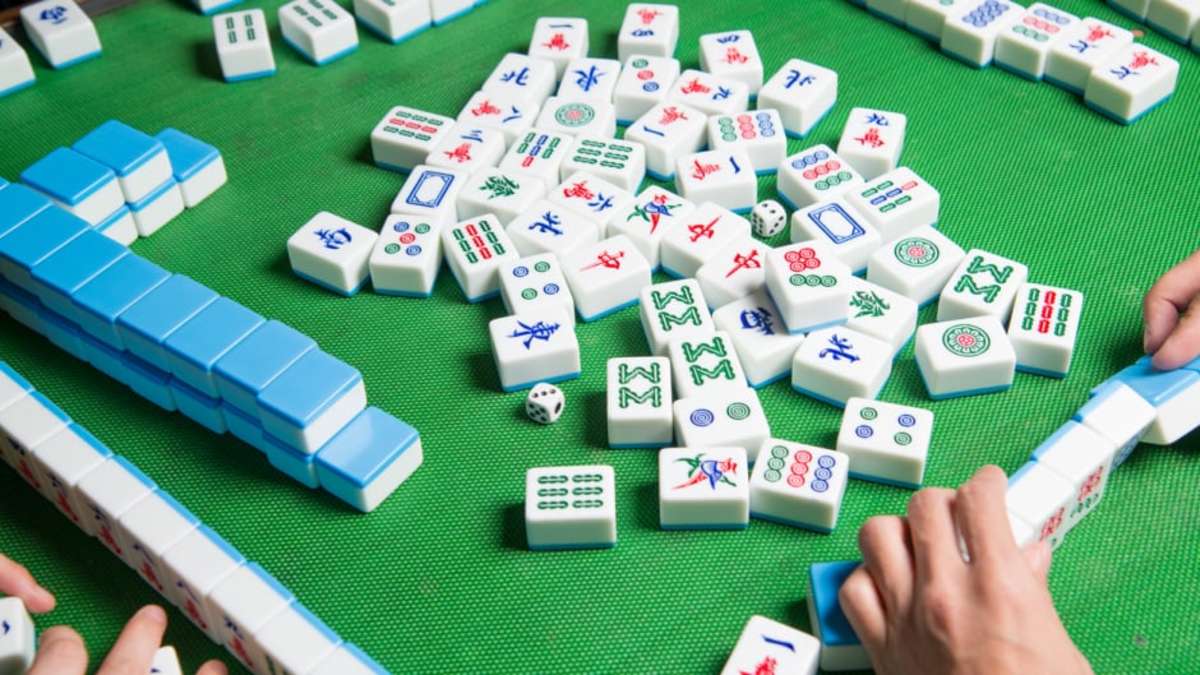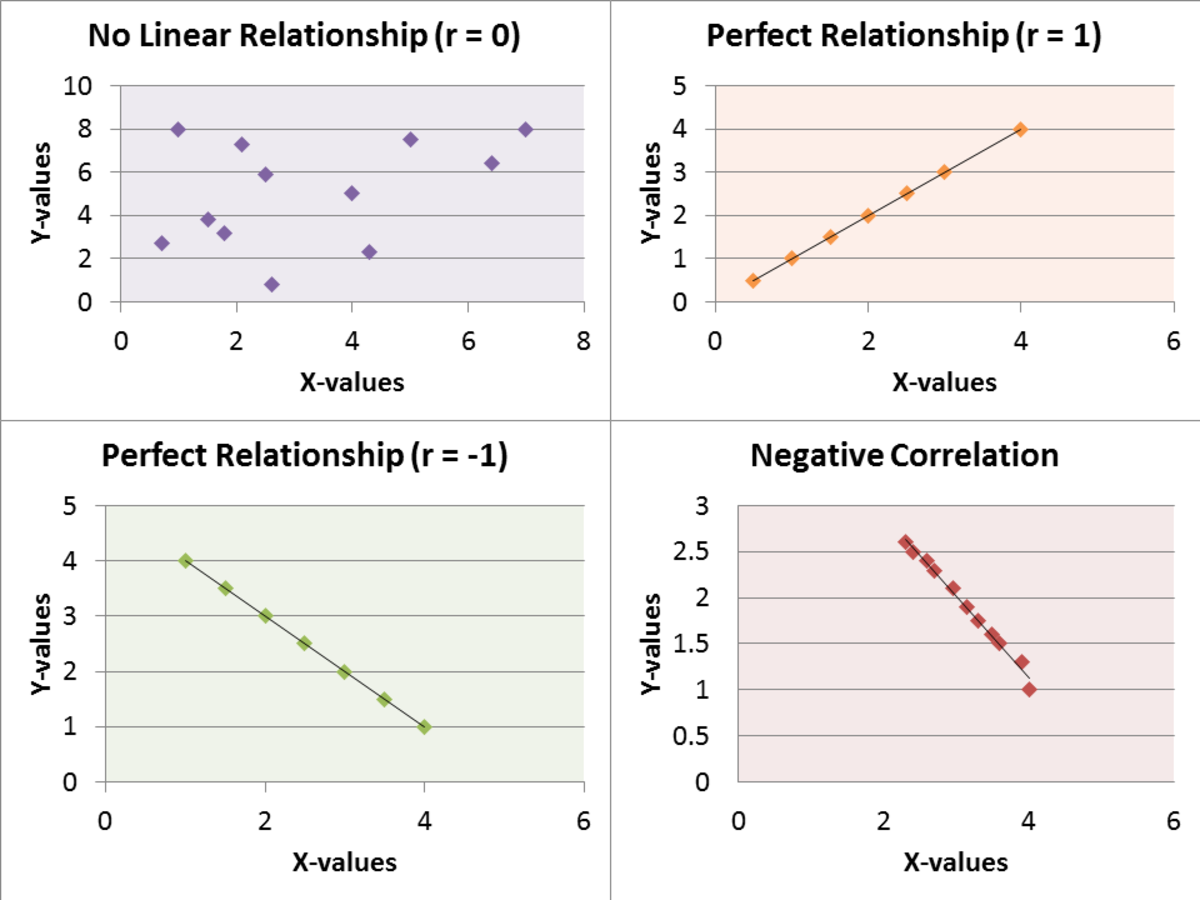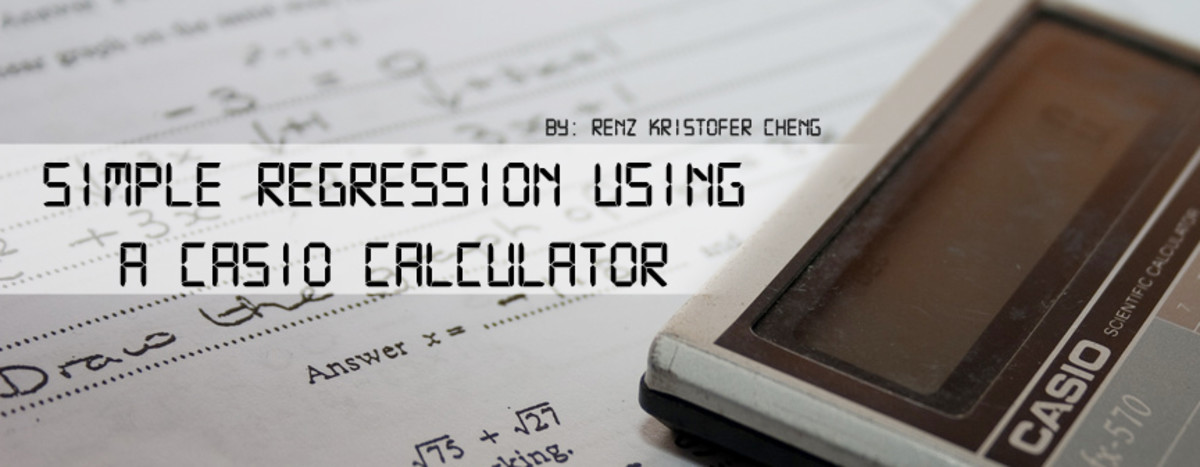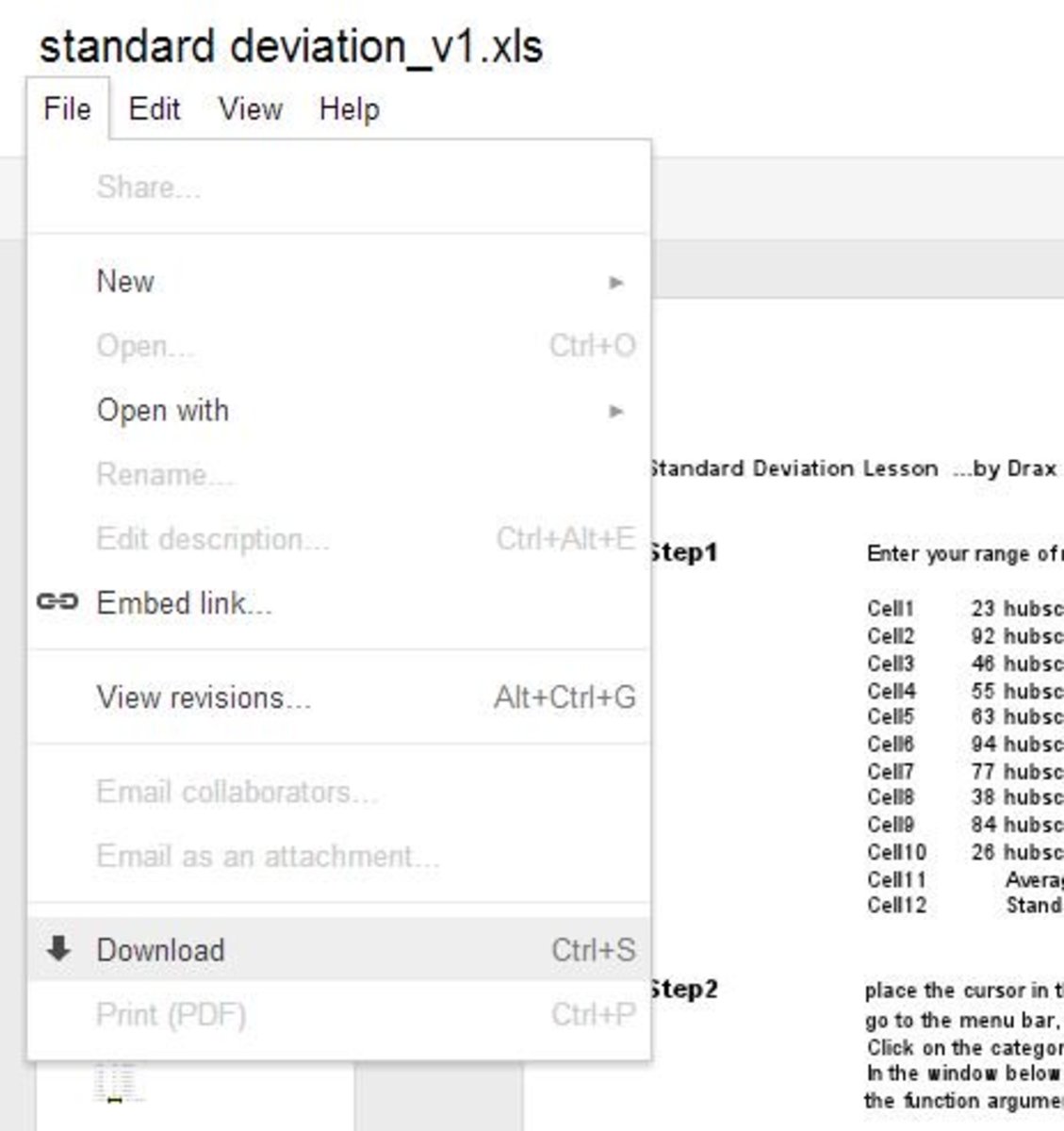Raise or Fold? Probability Based Poker Strategy and The Chances of Getting Dealt a Winning Hand
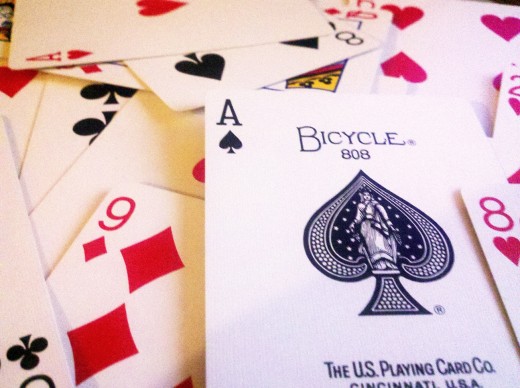
After reading a great article about Texas Hold 'Em the other day, I was inspired to write about the probabilities of getting dealt a particular hand in poker. Since I play the game with the statistics in mind, you can think of this article sort of like my own strategy guide for playing the game. My strategy is likely a bit different than most people's as it strongly based on probabilities and doesn't really involve bluffing or unnecessary risk taking. If you play the using this method you have the best chance of keeping your money for a longest period of time (possibly at the expense of being called a boring competitor by your friends because you will be thinking a lot). In this article, I will calculate the probability of being dealt a particular poker hand so that you can see what the odds of winning really are. After that, I will discuss some example hands for 5 card draw poker (jacks or better) and show the best strategy for playing based strictly on probabilities.
First, a Couple of Words About Cards and Winning Poker Hands
A standard deck of cards has 52 cards with the following characteristics:
- 26 of each color (red and black)
- 13 of every suit (hearts, diamonds, spades and clubs)
- 4 of every number card (2 – 10)
- 4 of every face or letter card (Jacks, Queens, Kings and Aces)
Winning hands in poker are as follows – a pair being the worst and a Royal Flush being the best.
- A pair - 2 of same number, face, or letter (2 – 10, Jack, Queen, King or Ace)
- Two pair - 2 of one number 2 – 10, J, Q, K or A and 2 of another.
- 3 of a kind – 3 of the same card 2 – 10, J, Q, K or A.
- Straight – 5 consecutive cards NOT in the same suit
- Flush – all the same suit
- Full House – a pair and 3 of a kind (Ex. 2, 2, 9, 9, 9)
- Straight Flush – 5 consecutive cards of the same suit (Ex. 3, 4, 5, 6, 7 of spades)
- Royal Flush – A, K, Q, J, 10 of all the same suit
Probabilities of Getting Dealt a Particular Poker Hand
First we must compute the total number of possible 5-card combinations. The number of ways 5 cards can be drawn from a deck of 52 would be 52C5 or (52!)/[(52-5)!(5!)] = 52!/47!5! = 2,598,960 possible hands.
A Pair:
1 card is pulled from 13 numbers, since both of those cards are the same number, they have to have 2 different suits from the possible 4 suits, the 3 remaining cards have to be pulled from the 12 remaining numbers (otherwise you could get 3 or 4 of a kind), and each of those cards can be pulled from any of the 4 possible suits. So, 13C1 x 4C2 x 12C3 x 4C1 x 4C1 x 4C1 = (13)(6)(220)(4)(4)(4) = 1,098,240 possible pairs. The probability of getting a pair is the number possible pairs divided by the number of possible hands (5 card combinations from a 52 card deck) = 1,098,240/2,598,960 = 0.4226 or 42.26%.
Two Pair:
2 cards pulled from a possible 13 numbers, each of those can have 2 out of the possible 4 suits, the remaining single card can only be pulled from the remaining 11 numbers. The fifth card can also have 1 out of 4 possible suits. So, 13C2 x 4C2 x 4C2 x 11C1 x 4C1 = (78)(6)(6)(11)(4) = 123,552 possible two pair sets. The probability of getting two pair is 123,552/2,598,960 = 0.04754 or 4.75%.
3 of a Kind:
The three cards each have to have a different suit, therefore each card can be pulled from 1 of the 13 numbers. The two remaining cards have to be pulled out of a possible 12 numbers and each of the those cards in the hand can have 1 out of 4 possible suits. So, 13C1 x 4C3 x 12C2 x 4C1 x 4C1 = (13)(4)(66)(4)(4) = 54,912 possible 3-of-a-kind sets. The probability of getting two pair is 54,912/2,598,960 = 0.02113 or 2.11%.
Straight:
A straight is a combination of 5 consecutive numbers of any suit (excluding all being the same suit). A straight would be 1) 2-3-4-5-6, 2) 3-4-5-6-7, etc. The are 10 such ordered sets and each of the five cards can have any suit. Since we want straights excluding the possibility of having them in the same suit, we need to subtract the probability of getting a straight flush. The probably of getting a straight flush is, again, 1 pulled from 10 sets, but this time all of them having a suit that is a single choice from 4 possibilities. So, 10C1 x 4C1 x 4C1 x 4C1 x 4C1 - 10C1 x 4C1 = (10)(4)(4)(4)(4)(4) – (10)(4) = 10,240 – 40 = 10,200 possible straight sets that are not straight flushes. The probability of getting a straight (excluding straight flushes) is 10,200/2,598,960 = 0.003924 or 0.392%.
Flush:
Since all of the 5 cards have to be the same suit, you will need to be dealt 5 cards out of a possible 13 numbers. Since all of those cards have to be the same suit, there is only 1 choice out of 4. We will assume that we don’t want a straight or royal flush because that is a much better hand, we need to subtract the probability of getting dealt it (see above). So, 13C5 x 4C1 - 10C1 x 4C1 = (1287)(4) – (10)(4) = 5,148 – 40 = 5,108 possible flush sets that are not straight flushes. The probability of getting a flush (excluding straight and royal flushes) is 5,108/2,598,960 = 0.0019654 or 0.197%.
Another (perhaps easier) way to compute this is to first assume that the first card you are dealt determines the suit for the flush (that is to say there is a 100% chance that the first card dealt to you will either be a diamond, spade, club, or heart). The probability of the second card be that same suit is 12/52, and the third is 11/50 and the 4th 10/49, and the fifth is 9/48. The probability of getting a flush is 1 x 12/51 x 11/50 x 10/49 x 9/48 = 0.0019808 or 0.198%. Note that this includes the straight and royal flushes, so it is slightly higher than the above calculation.
Full House:
A full house is a pair and a 3-of-a-kind set. Because of this, you start with the probability of getting a pair, but neglect the remaining three cards: Each card in the pair is pulled from a possible 13 and each one has to have a different suit: 13C1 x 4C2. The remaining 3 cards have to form a 3-of-a-kind set: the three cards each have to have a different suit and also have to be different than any of the cards that made the pair (12 possibilities now, not 13): 12C1 x 4C3. So, 13C1 x 4C2 x 12C1 x 4C3 = (13)(6)(12)(4) = 3,744 possible full house sets. The probability of getting a full house is 3,744/2,598,960 = 0.0014406 or 0.144%.
Straight Flush:
We computed this earlier. The probably of getting a straight flush is, again, 1 pulled from 10 sets, but this time all of them having a suit that is a single choice from 4 possibilities. So, 10C1 x 4C1 = (10)(4) = 40 possible straight flush sets. The probability of getting a straight flush is 40/2,598,960 = 0.0000153 or 0.00153%. Note that this includes the royal flushes. If we exclude the royal flushes, then there are only 36 possible hands (see below for royal flushes). The probability of getting a straight flush (excluding the royal flushes) is 36/2,598,960 = 0.0000139 or 0.00139%.
Royal Flush:
This is similar to the straight flush except that the set of 5 cards have to be specific (A-K-Q-J-10). There are only 4 possible suits where this exact combination can occur, and thus there are only 4 possible royal flush sets. This means that out of a possible 2,598,960 combinations of 5 cards, only 4 combinations can be royal flushes. The probability of getting dealt a royal flush is 4/2,598,960 = 0.00000153 or 0.000153%.
The table below summarizes the probabilities of getting dealt any of these hands.
Hand
| Example
| Possible 5-card Combinations
| Probability
|
|---|---|---|---|
Pair
| K-K-10-5-A
| 1,098,240
| 42.26%
|
Two Pair
| K-K-8-8-3
| 123,552
| 4.75%
|
3 of a Kind
| Q-Q-Q-8-4
| 54,912
| 2.11%
|
Straight
| 5-6-7-8-9
| 10,200
| 0.392%
|
Flush
| J-9-7-5-A (Same Suit)
| 5,108
| 0.196%
|
Full House
| 9-9-9-2-2
| 3,744
| 0.144%
|
Straight Flush
| 5-6-7-8-9 (Same Suit)
| 36
| 0.00139%
|
Royal Flush
| A-K-Q-J-10 (Same Suit)
| 4
| 0.00015%
|
Examples of a Probability Based Poker Strategy
Since the odds of getting dealt a favorable hand depend highly on the rules of the game you are playing, the winning criteria for the following examples must be defined first. When I play poker with my friends, the rules are simple. The game is 5 card draw where each player is dealt 5 cards and then given the opportunity to discard up to 3 cards for new ones. To have a winning hand, you must have at least a pair of jacks or better. With a probability based strategy, the goal is to keep any cards that will give you the best overall odds of getting a favorable hand. Note that the examples below don't take into account what any other players may have in their hands because it is impossible to know what cards they are holding. This strategy works really well when playing against "the house" or a computer based dealer.
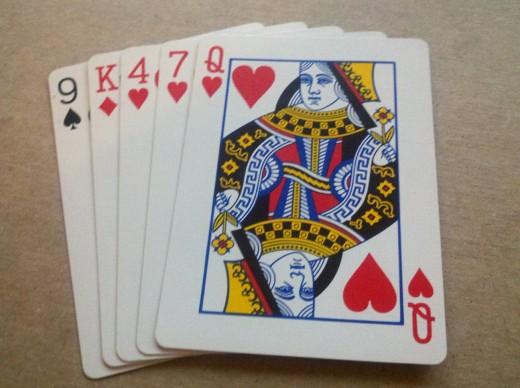
Example #1
At first glance you might want to discard the K and the 9 in hopes to get a flush. However, if you check the probabilities of getting dealt the required cards to get that hand, you will find that the odds are not in your favor. The chance of you getting dealt 2 cards back that would result in a flush is 10/47 x 9/46 which is 0.04162 or 4.16%.
If you want a better chance of having a favorable hand, you should keep the K and Q because we only need another one of those to get a pair of jacks or better. In this case, there are possibly six cards remaining in the deck that would instantly produce a win (3 kings and 3 queens) if we were dealt one of those. We don’t care what the other two remaining cards are, we just want one of those kings or queens and then we will have a winning hand. This means that the 3 card combination we must be dealt that would give us the best chance of winning is: (Any card)-(Any card)- (Q/K) which have respective probabilities of 47/47 x 46/46 x 6/45 = 6/45 = 0.13333 or 13.33%. (note that we are more likely to receive the winning card on the last of the 3 cards dealt than the first because the total amount of cards in the deck is smaller).
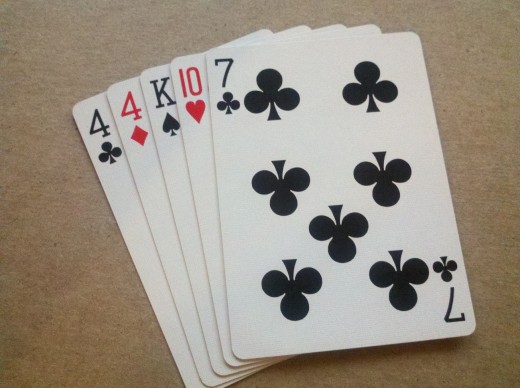
Example #2
If you look at the probabilities, keeping the two 4’s and discarding the rest in hopes of getting a 3-of-a-kind is actually not the best choice. This is because the chance of getting an additional 4 with 3 cards dealt back [combination (any)-(any)-(4)] is 47/47 x 46/46 x 2/45 = 4.44%. The best strategy here is to go for the most likely hand, which is always a pair of jacks, kings, queens, or Aces.
You will have the best chance of winning if you keep the 4’s and the K. To produce a win you will have to either get a 4 (2 of those left in the deck) or a king (3 of those left in the deck. (Either a pair of kings or a 3-of-a-kind set of 4’s) This is equivalent to the sum of the probabilities of getting a K-any card combination or a 4-any card combination: 47/47 x 3/46 + 47/47 x 2/46 = 0.0652 + 0.0434 = 0.1086 or 10.86%. (note that we are more likely to receive the winning card on the second card of the 2 cards dealt than the first because the total amount of cards in the deck is smaller).
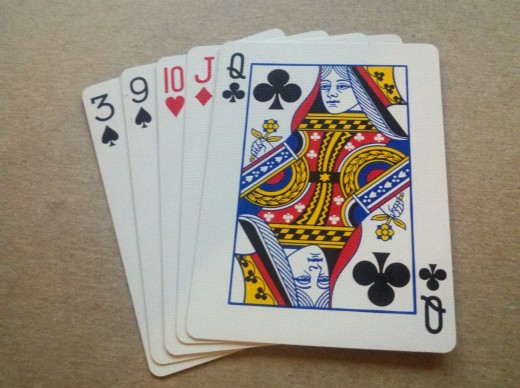
Example #3
Discarding the 3 and going for a straight is mighty tempting, but is it the wise choice? The chance of getting dealt an 8 or a K to produce a straight is 8/47 = 0.1702 or 17.02%.
That’s pretty good odds, however, what would happen if you tried for a pair? What if you kept the J & Q and discarded the rest in hopes of getting a second J or Q to result in a pair. We don’t care what the other two remaining cards are, we just want one of those jacks or queens dealt to use for a win. This means that the 3 card combination we must be dealt that would give us the best chance of winning is: (Any card)-(Any card)- (J/Q) which have respective probabilities of 47/47 x 46/46 x 6/45 = 6/45 = 0.13333 or 13.33%. (note that we are more likely to receive the winning card on the last of the 3 cards dealt than the first because the total amount of cards in the deck is smaller). So in this case, it would be wise to go for the straight!
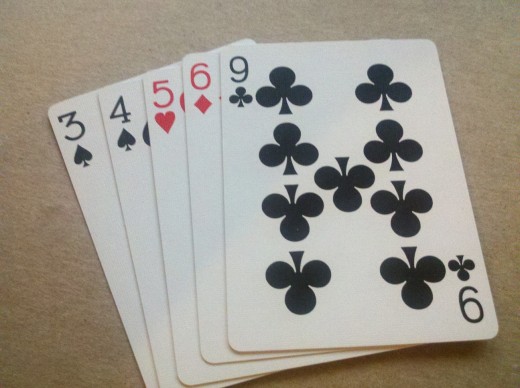
Example #4
Since there are no cards in your hand with a value of a Jack or higher, the obvious choice may be to drop the 9 and try for a straight. Getting a straight appears to be very likely to happen. The odds are 8/47 = 0.1702 = 17.02% to get dealt either a 2 or a 7 to get the straight.
What happens if you drop 3 cards and attempt to get at least 2 in return that will give you a jacks or better situation? To get that, you need to get dealt at least 2 out the 16 favorable cards to win. You probability of getting dealt that is: 47/47 x 16/46 x 15/45 = 0.3478 x 0.3333 = 11.59%. In this case, you are more likely to get the straight than you would be to get dealt a jacks or better hand.
Final Thoughts
If you haven't noticed already, it seems that the best strategy in many cases is to try to go for the pair of jacks or better. And in fact in most cases it is! Your odds of getting a dealt a Jacks or better hand is simply: 16/48 x 15/47 = 10.6% (assuming the first 3 cards dealt to you are not what you are looking for). A jacks or better hand is more than twice as likely to occur than two pair are (which is 4.75%). This is great information for a weekend in Vegas, but using this strategy may take some of the fun out of playing with your friends and family. However, if you're like me, it actually makes the game more fun!

